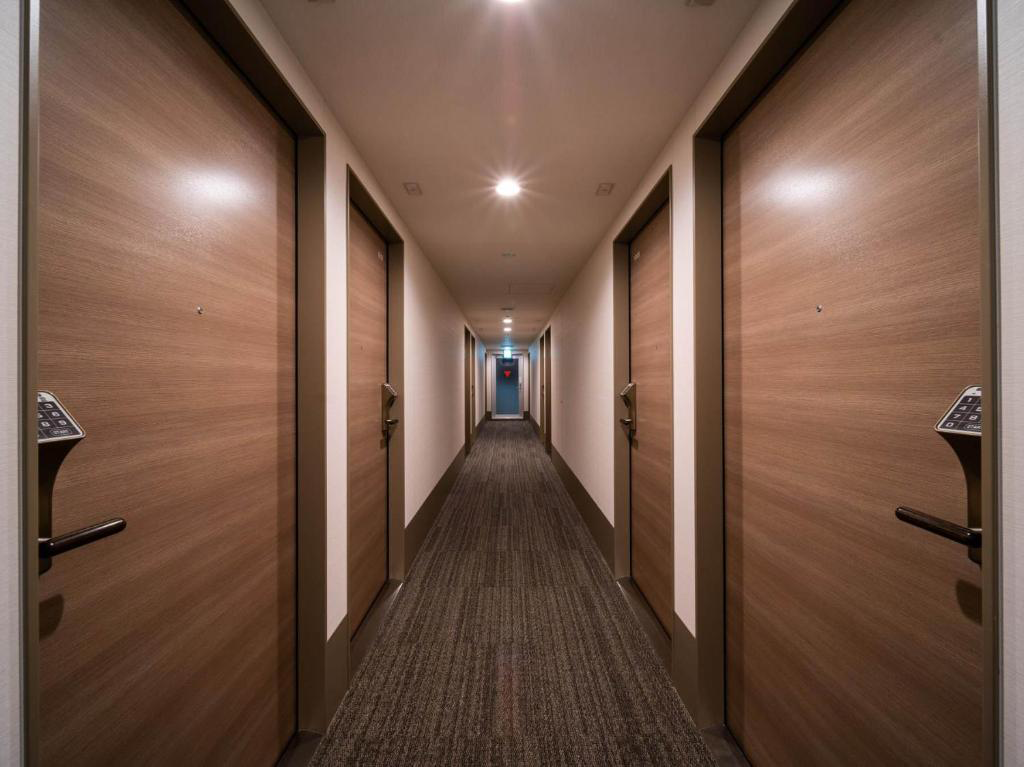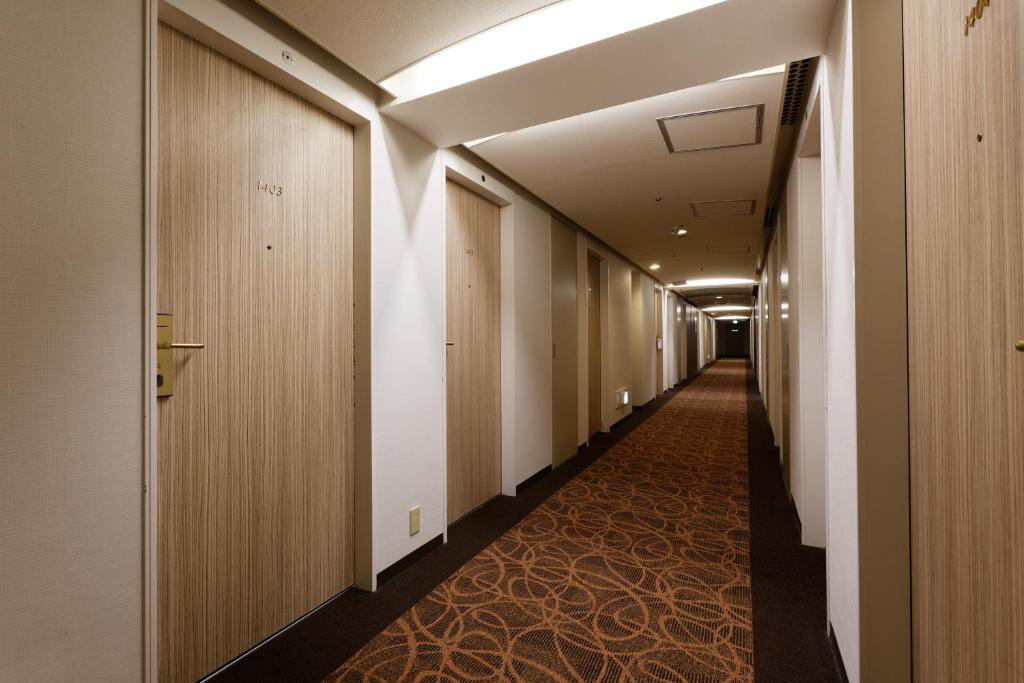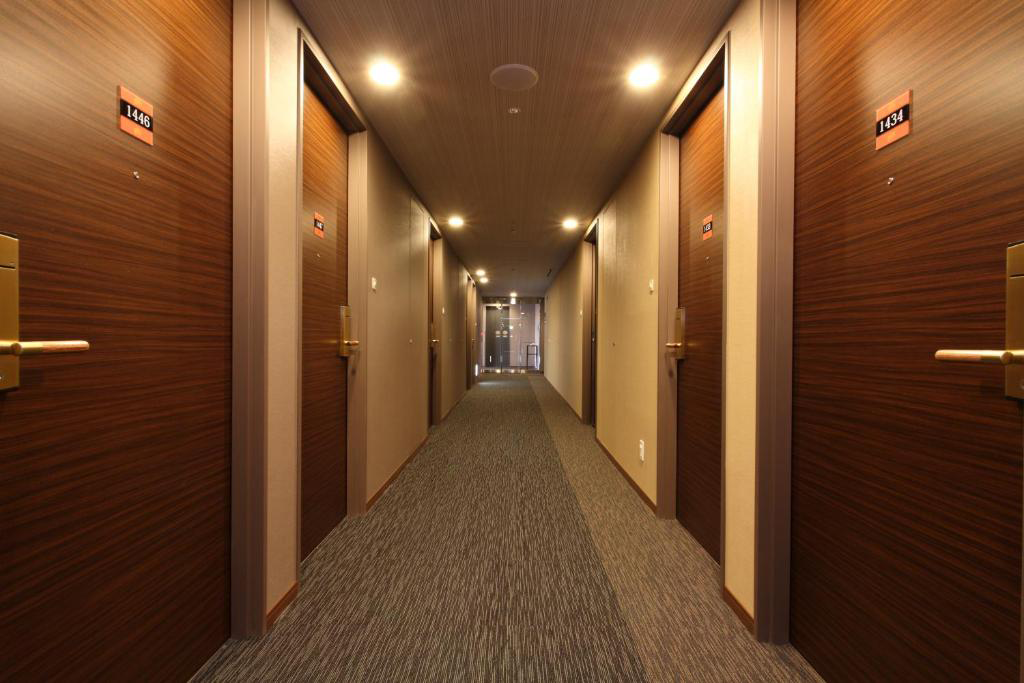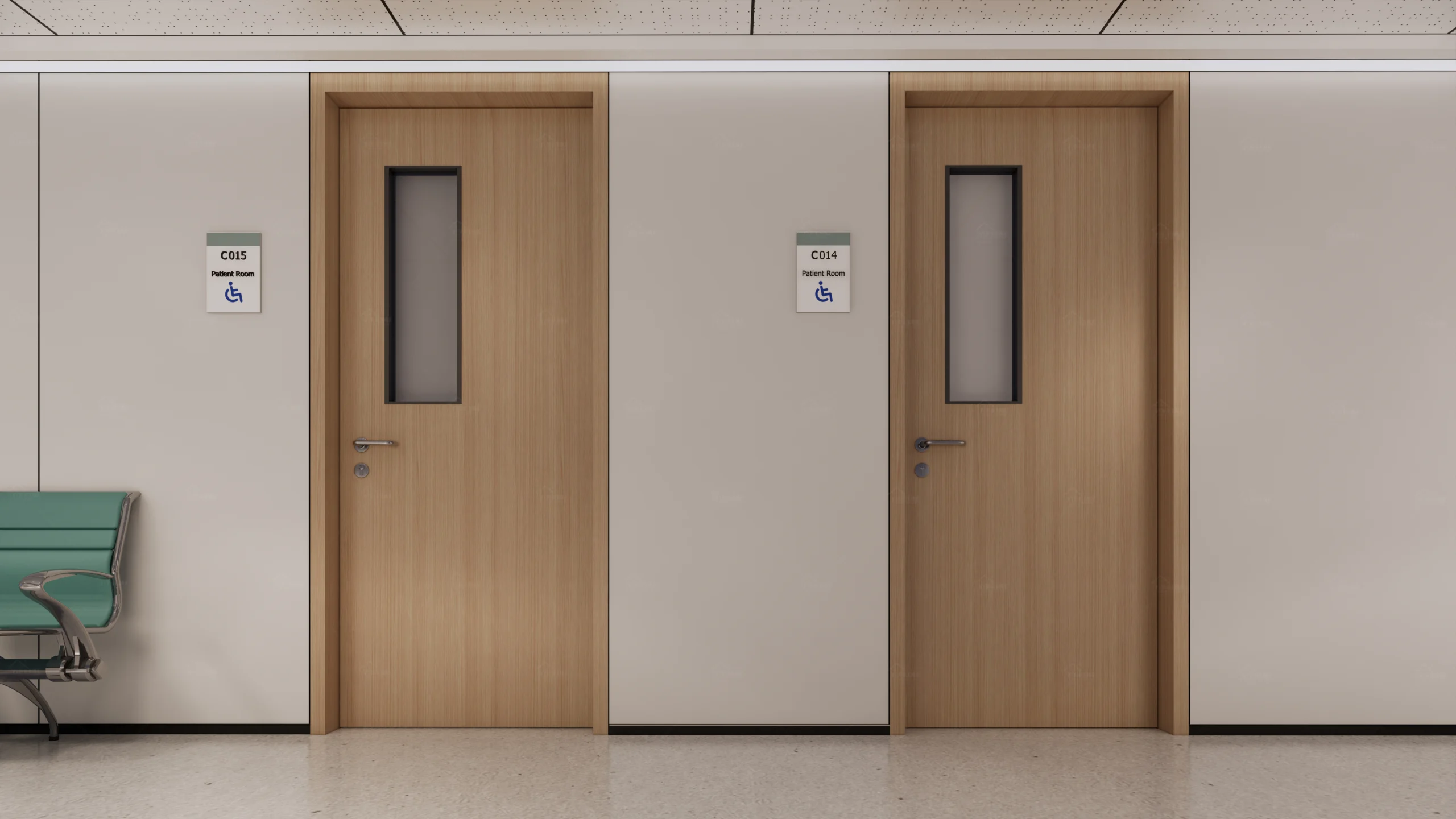A fire door is a special type designed to slow the spread of fire and smoke. Unlike regular doors, fire-rated doors have materials and components that can withstand high heat for a specific time, usually 30, 60, 90, or even 120 minutes. These doors give people more time to escape and help reduce building damage.
Fire door is an essential part of any fire safety system. You’ll find them in homes, offices, hotels, hospitals, schools, and commercial buildings. Many building codes and fire regulations require fire doors in certain areas, such as stairwells, hallways, and emergency exits.
A fire-rated door is not just the door itself—it includes fire-resistant frames, seals, hinges, and hardware. A fire door must be installed correctly and kept in reasonable condition to work properly. Even a tiny gap or missing seal can make the door less effective.
Fire door plays a huge role in protecting lives and property. When a fire breaks out, smoke and flames spread fast. A certified fire door slows down this process, keeping fire and toxic smoke contained in one area. This helps in three significant ways:
Fire door is not just about the door panel. Intumescent seals around the door edge expand when exposed to heat, sealing the gap and blocking smoke. Self-closing mechanisms ensure the door shuts automatically, which is crucial since an open fire door won’t work.
Many people assume fire door is only needed in commercial buildings. Still, residential fire doors are also a smart choice—especially for kitchens, garages, and basements, where fires are more likely to start.
Fire door comes in different materials, and each has its benefits. The most common types are:
Yes, fire door can be made of wood! These doors have a fire-resistant core, often made from solid timber, particleboard, or mineral core. Wood fire door is popular in homes, hotels, and offices because they look stylish and offer protection.
These are strong and durable. Metal fire door is standard in commercial buildings, factories, and warehouses where extra security is needed. They are often rated for 60 to 120 minutes of fire resistance.
Fire-rated glass is not like normal glass. It’s heat-resistant and won’t shatter easily. These doors are in modern offices, public buildings, and high-end homes.
Made of fireproof materials such as reinforced wood, fibreglass and resin. They are lightweight, durable and commonly used in apartment buildings and schools.
Each material has strengths, and the best choice depends on where the fire door will be used. For example, a wood fire door might be perfect for a home or hotel, while a steel fire door is better for an industrial setting.
When people hear “fire door,” they often think of heavy steel doors. But wooden fire door is just as safe as fire-rated and adequately installed. These doors are designed to slow down fire and smoke, giving people more time to escape. They are widely used in homes, hotels, offices, and commercial buildings where fire safety and aesthetics matter.
So, how can wood—a material that burns—resist fire? Let’s break it down.
Wood might not seem like an excellent material for fire door. However, with the proper treatment and construction, wood can be highly fire-resistant. Here’s how:
The inside of a wooden fire door is not just regular timber. It has a unique core made from fire-resistant materials like solid timber, particleboard, mineral core, or a combination. This helps slow down burning.
Some wood fire door is treated with fire-retardant chemicals. These coatings reduce flammability and prevent the wood from catching fire too quickly.
These are special seals around the door edges. When heat is exposed, they expand and block smoke and flames from passing through gaps.
Fire-rated wooden doors are thicker and denser than standard ones, giving them better heat and flame resistance.
Depending on its fire rating, an adequately designed wooden fire door can withstand fire for 30, 60, or even 90 minutes.
The core of a wooden fire-rated door makes it resistant to fire. At the same time, the outer layer might be natural wood veneer, laminate, or paint; the inside matters most. Here are the most common types of fire-rated cores:
Made from dense, fire-resistant hardwood, this core burns slowly and predictably, making it a good choice for fire doors in residential and commercial buildings.
A high-density wood-based core that offers good fire resistance. Often used in office doors and apartment fire doors.
Made from non-combustible materials, this core offers the highest level of fire protection and is commonly used in hospital and hotel fire doors.
A lightweight, fire-resistant structure that balances strength and fire safety.
The core type affects the fire rating of a wooden fire door. For example, an FD30 wooden fire door (30-minute fire resistance) might have a solid timber core, while an FD60 fire door (60-minute rating) may use a mineral core for extra protection.
A fire-rated wooden door must pass strict fire tests to be legally sold and used. These tests check how well the door resists fire, heat, and smoke. Here’s how it works:
The door is placed in a fire-testing chamber and exposed to extreme heat (over 900°F / 500°C). It must resist flames for 30, 60, 90, or 120 minutes, depending on the rating.
Since smoke is the most significant cause of fire deaths, a wood fire door must also prevent toxic smoke from spreading. The test checks whether the intumescent seals block smoke properly.
Fire doors must stay intact even in harsh conditions. Some tests simulate real fire scenarios, like sudden pressure changes from an explosion.
After passing these tests, the door gets a fire rating certification. The most common fire door standards include:
A certified wooden fire door will have a fire label showing its rating and compliance. Always check this label before buying or installing a fire door.
Not all wooden fire door offer the same level of protection. The fire rating tells us how long a fire-rated door can resist flames and smoke before failing. Understanding these ratings is key when choosing the right fire door for your home, office, or commercial building.
Fire door is often labelled FD30, FD60, FD90, or FD120. But what do these numbers mean?
This is the most common fire door rating, often used in homes, apartments, and offices. It can withstand fire for 30 minutes.
This door offers 60 minutes of fire resistance. It is used in hotels, schools, and commercial buildings where extra protection is needed.
This door provides 90 minutes of fire resistance, which is usually required for high-risk areas like stairwells, factories, and hospitals.
This is the highest-rated door, offering 120 minutes of protection. It is used in industrial buildings, large commercial spaces, and critical fire escape routes.
The higher the rating, the better the protection. However, fire safety isn’t just about time—it also depends on proper installation, fire-resistant seals, and certified hardware.
To be legally sold and used, fire-rated wooden doors must pass strict fire safety tests. These tests ensure the door can resist flames, high heat, and smoke under fire conditions. Different countries follow different standards, but here are the most common ones:
A top standard for fire door in North America. This test measures how long a fire door can withstand fire and checks if it remains intact under pressure and heat.
This is the British fire safety standard. FD30, FD60, FD90, and FD120 doors in the UK must pass this test before they can be used in buildings.
A strict European standard for fire-resistant doors. It tests fire resistance, smoke control, and heat insulation.
The fire testing standard for Australian fire door, ensuring they meet local building codes.
These standards follow real-world fire scenarios, checking how long the door can withstand extreme temperatures and prevent fire spread. Fire doors that pass these tests get a fire certification label, proving they meet safety regulations.
Wooden fire door plays a crucial role in fire safety, helping slow the spread of flames and smoke. But what goes into making these specialized doors? Every component, from fire-resistant wood to protective seals and finishes, is carefully chosen to meet strict fire regulations. Let’s look at how wooden fire doors are made and what makes them different from standard wooden doors.
Not all wood is created equal when it comes to fire doors. Regular wood burns quickly, making it unsuitable for fire-rated doors. Fire-resistant wood, on the other hand, is specially treated or combined with fire-retardant materials to improve its ability to withstand heat.
Many wooden fire doors use hardwood veneers or engineered wood with fire-resistant cores. These materials slow combustion and provide the necessary fire rating, whether 30, 45, 60, or even 90 minutes. The fire rating tells you how long the door can resist flames before breaking down. Choosing the right materials ensures that a fire-rated door meets safety standards without sacrificing aesthetics.
The core of a wooden fire door is what gives it strength and fire resistance. There are several core types used in fire doors, each offering different levels of protection:
Made from high-density wood or engineered wood, solid core fire doors are durable and have good fire resistance.
A cost-effective option, particleboard cores offer moderate fire resistance and are often used in commercial fire doors.
This is a non-combustible core made from mineral-based materials. It provides excellent fire resistance and is common in high-rated fire doors, such as 60-minute or 90-minute doors.
A combination of fire-resistant materials layered together to enhance fire performance.
Each core type is tested to ensure compliance with fire safety regulations. The right core choice depends on the fire rating required and the door’s intended use.
A fire door is more than fire-resistant wood; it includes key components like intumescent seals. These seals are installed around the edges of the door and frame. Under normal conditions, they remain inactive. But when exposed to high heat, they expand, creating a tight barrier that blocks smoke and flames.
Intumescent seals are essential for a fire-rated door to perform correctly. Without them, flames and toxic gases could pass through the gaps around the door, reducing its effectiveness. Some fire doors also include smoke seals, which prevent smoke from spreading before the fire reaches full intensity. This added protection gives people more time to evacuate safely.
The final layer of a wooden fire door isn’t just about looks—it also plays a role in fire resistance. Fire-rated finishes include:
This is specially formulated paint that helps maintain the door’s fire rating while providing a sleek, durable surface.
A thin layer of real wood applied to the door’s surface for a natural appearance. Fire-rated veneers are treated to resist ignition.
A tough, durable finish offering additional protection and various design options.
Fire-rated doors must maintain their fire resistance even after finishing. All paints, veneers, and laminates used on fire doors must meet fire safety standards.
When choosing fire doors, one big question arises: wooden or steel fire doors? Both types offer fire protection but have key differences in durability, cost, and appearance. The right choice depends on where and how the door will be used.
Wooden fire doors are popular for many reasons. They combine safety with a classic look that blends well in homes, hotels, and offices. But, like anything, they have pros and cons.
Wooden fire door is an essential safety feature in many buildings. They help slow the spread of fire and smoke, giving people more time to escape. These doors are standard in homes and commercial spaces, balancing fire protection with an appealing look. Below are the key places where fire doors are used.
Fire door helps protect families and property in homes and apartments. Many modern homes have wooden fire doors installed in key areas like kitchens, hallways, and basement entrances. These doors are especially important in apartment buildings, where fire can spread quickly between units. Fire-rated doors in multi-family housing often meet strict safety standards to ensure protection for all residents.
Another advantage of wooden fire door is their stylish appearance. Unlike metal fire doors, wooden options blend well with home decor while offering excellent fire resistance. Homeowners can choose from different finishes, ensuring both safety and aesthetics.
Hotels, schools, and hospitals must follow strict fire safety regulations. Fire door is vital in keeping guests, students, and patients safe during emergencies. In hotels, wooden fire doors are often used in guest rooms, hallways, and stairwells to prevent fire from spreading. These doors also reduce noise, making them a practical choice for a comfortable stay.
In schools, fire door protects classrooms and corridors. With high foot traffic in educational buildings, fire-rated doors help ensure safe evacuation routes in an emergency. Similarly, hospitals rely on fire door to keep patients, staff, and visitors safe. Many hospital fire door also has glass panels to allow visibility while maintaining fire resistance.
Fire door is required in offices and commercial buildings to meet workplace safety codes. These doors are typically installed in stairwells, storage rooms, and between office sections to slow down fire and smoke. In large buildings, fire door is often combined with automatic closing systems that activate when fire alarms go off. This helps contain the fire and protect employees and assets.
Public spaces like shopping malls, theatres, and government buildings also use wooden fire doors to ensure safety. Since these areas have high visitor traffic, having properly rated fire doors can save lives by preventing fire from spreading too quickly.
Wooden fire door balance safety and style. They are widely used in homes, apartments, hotels, schools, hospitals, offices, and commercial spaces. Whether for fire protection, noise reduction, or design appeal, these doors play a crucial role in modern buildings. Investing in high-quality fire doors can improve both security and peace of mind.
Certified wooden fire door protects lives and property during a fire. They are specifically designed to slow the spread of fire and smoke, giving people more time to escape and reducing damage to buildings. These doors must meet strict safety standards and are tested to ensure they can withstand heat and flames for a specified period, typically 30 minutes (FD30) or 60 minutes (FD60). Below, we will explore some critical components that make a certified wooden fire door effective, safe, and reliable.
The fire-rated door frame is more than just a structural component—it’s critical to the performance of the entire fire door system. A certified fire door is useless if the frame cannot withstand the same level of heat and stress. Fire-rated frames are built from durable materials like hardwood or specially engineered fire-resistant composites. They’re designed to resist warping or collapse when exposed to high temperatures.
Proper installation of the fire-rated door frame is equally important. Even a tiny gap between the door and frame can allow smoke or fire to pass, compromising the door’s safety. That’s why certified wooden fire doors and their frames are tested together. Always ensure the frame matches the door’s fire rating for maximum protection.
The hardware on fire door matters as much as the door and frame. Fire-rated hinges, locks, and handles are designed to stay functional under extreme heat and pressure. For example, fire-rated hinges are made of high-strength metals that won’t melt or deform when exposed to fire. These hinges allow the door to stay securely in place, even in the most challenging conditions.
Similarly, locks and handles on certified wooden fire door must also meet fire-resistance standards. They are tested to ensure they don’t contribute to the spread of fire or smoke. Using approved hardware is essential because standard fittings could compromise the fire door’s performance. Always check for certifications like CE marking to ensure compliance with local fire safety regulations when installing or replacing hardware.
Smoke is often more dangerous than fire, as it can spread quickly and cause suffocation. That’s why certified wooden fire door come with smoke seals. These seals are typically placed around the edges of the door and expand when exposed to heat, sealing any gaps that smoke could pass through. They play a key role in keeping escape routes clear of smoke for as long as possible.
Automatic door closers are another essential feature of fire door. They ensure the door remains closed, which is crucial during a fire. If a fire door is left open, it cannot perform its job. Modern closers are designed to be smooth and quiet, making them less disruptive in daily use while still providing maximum safety in an emergency.
Many people wonder whether glass panels on a fire door compromise its safety. The good news is that fire-rated glass is precisely engineered to resist heat and flames like the rest of the door. These glass panels are tested to ensure they meet the same fire-resistance standards as the wooden fire door.
Fire-rated glass is typically made of toughened or laminated materials that withstand high temperatures without cracking or breaking. The glass is sometimes treated with a special coating to increase its fire resistance. If you’re considering a fire door with glass panels, ensure the glass is certified and installed correctly. Not only do these panels provide safety, but they also allow visibility, which can be crucial for emergency responders during a fire.
Certified wooden fire door is essential to any building’s fire safety system. From fire-rated frames and hardware to smoke seals and glass panels, every component keeps people safe during a fire. When choosing or maintaining fire door, ensure all parts are certified and meet local regulations. Remember, fire doors aren’t just doors—they’re lifesaving barriers that protect people and property when it matters most.
Proper installation and regular maintenance are essential to ensure wooden fire door works as they should. Even the best fire-rated doors won’t perform effectively if installed poorly or maintained regularly. Below, we’ll cover how to install a fire-rated wooden door correctly, what to include in a fire door inspection checklist, and the signs that your fire door needs repair or replacement.
Installing a fire-rated wooden door isn’t the same as installing a regular door. Every step needs precision to ensure the door performs as a fire barrier when needed. Here’s what you need to know:
The fire door must be installed with a compatible fire-rated frame, hinges, locks, and other hardware. These components must match the door’s fire rating to maintain its integrity.
The gap between the door and frame should typically be no more than 3-4mm. More significant gaps can allow smoke and fire to pass through. Also, check the bottom gap; this should align with fire safety regulations in your area.
Smoke seals are critical. They prevent smoke from escaping through the edges of the door. Be sure they are correctly positioned and securely attached.
Fire doors should permanently be installed by trained professionals. Certified installers follow strict guidelines to ensure the door complies with fire safety standards.
Once installed, test the door to confirm it closes appropriately, seals tightly, and functions as expected. Fire doors should close automatically and latch securely.
Proper installation ensures that your fire door can delay the spread of fire and smoke, giving occupants more time to exit safely.
Fire doors need regular inspections to remain effective. Over time, wear and tear, misuse, or even building movement can affect their performance. Here’s a simple checklist to follow during a fire door inspection:
Look for the certification label or plate on the door. This confirms the door is fire-rated and compliant with safety standards.
Ensure the frame is intact, securely fixed, and free from damage or warping. A damaged frame can compromise the entire fire door.
All hinges and hardware should be fire-rated, securely attached, and in good condition. Look for loose screws or missing parts.
Check the gaps around the door. They must be consistent and within the recommended range (3-4mm). More significant gaps need immediate adjustment.
The door should close smoothly and latch securely without being pushed. If it doesn’t, the closer may need adjustment or replacement.
Ensure seals and strips are intact and not damaged or missing. Replace them if they are worn out.
Performing this inspection at least once every six months can help identify issues before they become significant problems.
Even with regular inspections, fire doors can wear out over time. Knowing when to repair or replace your fire door is critical for maintaining safety. Here are the key signs to watch for:
Cracks, dents, or warping in the door or frame can weaken its ability to resist fire and smoke. If the damage is severe, replacement is often the best option.
If the hinges, locks, or handles no longer function correctly, they may need repair or replacement. Always use fire-rated hardware to maintain compliance.
Smoke seals and intumescent strips can become brittle or damaged over time. Replace them if they are peeling, cracked, or missing.
A fire door that doesn’t close fully or latch automatically is a significant safety hazard. This issue must be fixed immediately.
If the certification label or plate is missing or unreadable, verifying the door’s fire rating is tricky. In this case, consider replacing the door to ensure compliance.
If the gaps around the door are too broad and can’t be adjusted, it may be time to replace the door or frame.
If you notice any of these issues, act quickly. Repair or replace the door as needed to ensure it continues to provide the protection it was designed for.
Installing and maintaining wooden doors is crucial for fire safety. Proper installation ensures the door performs as intended. At the same time, regular inspections and timely repairs keep them in top condition. Fire doors are more than just doors—they’re lifesaving tools that protect people and property. Always prioritize their upkeep and work with certified professionals to ensure compliance with safety standards.
Share This Story, Choose Your Platform!












